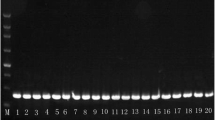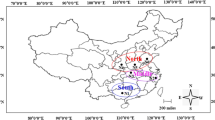Abstract
Between March and September 2012, grapevines in vineyards of Meshginshahr county located in Ardabil province as well as Azarshahr, Ajab Shir, and Malekan counties located in East Azerbaijan province, north-western Iran represented general decline symptoms and in some cases black vascular discoloration. Annular or irregular discoloration, dark vascular streaking, and V-shaped unilateral canker or brown necrosis were observed in the pit and vascular tissues of the infected stems. These symptoms were accompanied with necrotic and wilted leaves. Nine fungal isolates having analogous morphological traits were recovered from symptomatic tissues on potato dextrose agar culture medium. Morphological and molecular characterizations confirmed the identity of all nine isolates as Kalmusia variispora (formerly known as Dendrothyrium variisporum). Random amplified polymorphic DNA (RAPD) and inter-simple sequence repeat (ISSR) analyses were conducted for genetic diversity assessment of 13 K. variispora isolates from grapevine, one isolate from Rosa hybrida and one isolate from Pinus eldarica and the results indicated the existence of polymorphism among the isolates (77.27% and 81.25% for RAPD and ISSR, respectively). The clustering of RAPD and ISSR analyses revealed that there was no correlation between the isolates and their geographical as well as host origins. A pathogenicity assay confirmed K. variispora to be pathogenic on grapevine plants (cv. Keshmeshi) causing similar symptoms as those observed in naturally infected grapevines. Kalmusia variispora is associated with grapevine decline symptoms and grapevine trunk disease in Iran.








Similar content being viewed by others
References
Abed-Ashtiani, F., Kadir, J., Nasehi, A., Hashemian-Rahaghi, S. R., Vadamalai, G., & Rambe, S. K. H. (2016). Characterisation of Magnaporthe oryzae isolates from rice in peninsular Malaysia. Czech Journal of Genetics and Plant Breeding, 52(4), 145–156.
Abed-Ashtiani, F., Narmani, A., & Arzanlou, M. (2018). Macrophomina phaseolina associated with grapevine decline in Iran. Phytopathologia Mediterranea, 57(1), 107–111.
Altschul, S. F., Madden, T. L., Schaffer, A. A., Zhang, J., Zhang, Z., Miller, W., & Lipman, D. J. (1997). Gapped BLAST and PSI-BLAST: A new generation of protein database search programs. Nucleic Acids Research, 25(17), 3389–3402.
Ariyawansa, H. A., Tanaka, K., Thambugala, K. M., Phookamsak, R., Tian, Q., Camporesi, E., Hongsanan, S., Monkai, J., Wanasinghe, D. N., Mapook, A., Chukeatirote, E., Kang, J. C., Xu, J. C., McKenzie, E. H. C., Jones, E. B. G., & Hyde, K. D. (2014). A molecular phylogenetic reappraisal of the Didymosphaeriaceae (= Montagnulaceae). Fungal Diversity, 68(1), 69–104.
Armijo, G., Schlechter, R., Agurto, M., Muñoz, D., Nuñez, C., & Arce-Johnson, P. (2016). Grapevine pathogenic microorganisms: Understanding infection strategies and host response scenarios. Frontiers in Plant Science, 7, 382.
Arzanlou, M., & Khodaei, S. (2012). Aureobasidium iranianum, a new species on bamboo from Iran. Mycosphere, 3, 404–408.
Arzanlou, M., & Narmani, A. (2015). ITS sequence data and morphology differentiate Cytospora chrysosperma associated with trunk disease of grapevine in northern Iran. Journal of Plant Protection Research, 55(2), 117–125.
Arzanlou, M., Moshari, S., Bakhshi, M., & Khodaei, S. (2012). First report of Botryosphaeria dothidea associated with grapevine decline disease in Iran. Australasian Plant Disease Notes, 7, 197–200.
Arzanlou, M., Moshari, S., Salari, M., & Badali, H. (2013a). Molecular characterization and pathogenicity of Phaeoacremonium spp. associated with esca disease of grapevine in northern Iran. Archives of Phytopathology and Plant Protection, 46(4), 375–388.
Arzanlou, M., Narmani, A., Moshari, S., Khodaei, S., & Bababi-ahari, A. (2013b). Truncatella angustata associated with grapevine trunk disease in northern Iran. Archives of Phytopathology and Plant Protection, 46(10), 1168–1181.
Arzanlou, M., Narmani, A., Moshari, S., & Khodaei, S. (2014). Pome and stone fruit trees as possible reservoir hosts for Phaeoacremonium spp., the causal agents of grapevine esca disease, in Iran. Archives of Phytopathology and Plant Protection, 47(6), 717–727.
Bruno, G., & Sparapano, L. (2007). Effects of three esca-associated fungi on Vitis vinifera L.: V. Changes in the chemical and biological profile of xylem sap from diseased cv. Sangiovese vines. Physiological and Molecular Plant Pathology, 71, 210–229.
Cloete, M., Fischer, M., Mostert, L., & Halleen, F. (2014). A novel Fomitiporia species associated with esca on grapevine in South Africa. Mycological Progress, 13(2), 303–311.
Crous, P. W., Schumacher, R. K., Wingfield, M. J., Lombard, L., Giraldo, A., Christensen, M., et al. (2015). Fungal systematics and evolution: FUSE 1. Sydowia, 67, 81–118.
Essakhi, S., Mugnai, L., Crous, P. W., Groenewald, J. Z., & Surico, G. (2008). Molecular and phenotypic characterization of novel Phaeoacremonium species isolated from esca diseased grapevines. Persoonia, 21, 119–134.
Farr, D. F., & Rossman, A. Y. (2018). Fungal databases. U.S. National Fungus Collections, ARS, USDA. https://nt.ars-grin.gov/fungaldatabases/.
Fontaine, F., Gramaje, D., Armengol, J., Smart, R., Annamaria, Z., Borgo, M., et al. (2016). Grapevine trunk diseases. A review. Paris, France: OIV publications, international organisation of vine and wine. ISBN : 979–10–91799-60-7.
Fotouhifar, K. B., Hedjaroude, G. A., & Leuchtmann, A. (2010). ITS rDNA phylogeny of Iranian strains of Cytospora and associated teleomorphs. Mycologia, 102(6), 1369–1382.
Ghobad-Nejhad, M., Asgari, B., & Chaharmiri Dokhaharani, S. (2017). Notes on some endophytic fungi isolated from Quercus brantii in Dena region of Kohgiluyeh and Boyer-Ahmad province, Iran. Mycologia Iranica, 4(1), 1–12.
Gonthier, P., Gennaro, M., & Nicolotti, G. (2006). Effects of water stress on the endophytic mycota of Quercus robur. Fungal Diversity, 21, 69–80.
González, V., & Tello, M. L. (2011). The endophytic mycota associated with Vitis vinifera in Central Spain. Fungal Diversity, 47, 29–42.
Gonzalez-Mendoza, D., Argumedo-Delira, R., Morales-Trejo, A., Pulido-Herrera, A., Cervantes-Diaz, L., Grimaldo-Juarez, O., et al. (2010). A rapid method for isolation of total DNA from pathogenic filamentous plant fungi. Genetics and Molecular Research, 9, 162–166.
Gramaje, D., Mostert, L., & Armengol, J. (2011). Characterization of Cadophora luteo-olivacea and C. melinii isolates obtained from grapevines and environmental samples from grapevine nurseries in Spain. Phytopathologia Mediterranea, 50(4), 112–126.
Hosen, M. I., Ahmed, A. U., Zaman, J. J., Ghosh, S., & Hossain, K. M. K. (2009). Cultural and physiological variation between isolates of Stemphylium botryosum the causal of Stemphylium blight disease of lentil (Lens culinaris). World Journal of Agricultural Sciences, 5, 94–98.
Kumar, S., Stecher, G., & Tamura, K. (2016). MEGA7: Molecular evolutionary genetics analysis version 7.0 for bigger datasets. Molecular Biology and Evolution, 33, 1870–1874.
Lawrence, D. P., Travadon, R., Pouzoulet, J., Rolshausen, P. E., Wilcox, W. F., & Baumgartner, K. (2017). Characterization of Cytospora isolates from wood cankers of declining grapevine in North America, with the descriptions of two new Cytospora species. Plant Pathology, 66(5), 713–725.
Maharachchikumbura, S. S., Larignon, P., Hyda, K. D., Al-Sadi, A., & Liu, Z. (2016). Characterization of Neopestalotiopsis, Pestalotiopsis and Truncatella species associated with grapevine trunk diseases in France. Phytopathologia Mediterranea, 55(3), 380–390.
Mohammadi, H., Banihashemi, Z., Gramaje, D., & Armengol, J. (2013). Fungal pathogens associated with grapevine trunk diseases in Iran. Journal of Agricultural Science and Technology, 15, 137–150.
Moricca, S., & Ragazzi, A. (2008). Fungal endophytes in Mediterranean oak forests: A lesson from Discula quercina. Phytopathology, 98, 380–386.
Moricca, S., Ginetti, B., & Ragazzi, A. (2012). Species and organ specificity in endophytes colonizing healthy and declining Mediterranean oaks. Phytopathologia Mediterranea, 51, 587–598.
Mostert, L., Groenewald, J. Z., Summerbell, R. C., Gams, W., & Crous, P. W. (2006). Taxonomy and pathology of Togninia (Diaporthales) and its Phaeoacremonium anamorphs. Studies in Mycology, 54, 1–115.
Nylander, J. A. A. (2004). MrModeltest v. 2.0. Program Distributed by the Author. Uppsala, Sweden: Evolutionary Biology Centre, Uppsala University.
Rayner, R. W. (1970). A Mycological Colour Chart. Kew. In Surrey. England: CMI and British Mycological Society.
Rohlf, F. J. (2000). NTSYS-pc Numerical Taxonomy and Multivariate Analysis System Version 2.1. New York: Exeter Publishing Setauket.
Ronquist, F., & Huelsenbeck, J. P. (2003). MRBAYES 3: Bayesian phylogenetic inference under mixed models. Bioinformatics, 19, 1572–1574.
Scheuermann, K. K., Raimondi, J. V., Marschalek, R., Andrade, A., & Wickert. E. (2012). Magnaporthe oryzae genetic diversity and its outcomes on the search for durable resistance. In M. Caliskan (Ed.), The Molecular Basis of Plant Genetic Diversity. InTech.
Úrbez-Torres, J. R., Adams, P., Kamas, J., & Gubler, W. D. (2009). Identification, incidence, and pathogenicity of fungal species associated with grapevine dieback in Texas. American Journal of Enology and Viticulture, 60(4), 497–507.
Urbez-Torres, J., Peduto, F., & Gubler, W. (2012). Phomopsis dieback: 40 years of ignoring a grapevine trunk disease In: ICGTD (International Council on Grapevine Trunk Disease) 8th International Workshop on Grapevine Trunk Disease. Valencia, Spain 18–21 June.
Úrbez-Torres, J. R., Peduto, F., Smith, R. J., & Gubler, W. D. (2013). Phomopsis dieback: A grapevine trunk disease caused by Phomopsis viticola in California. Plant Disease, 97(12), 1571–1579.
Verkley, G. J. M., Dukik, K., Renfurm, R., Goker, M., & Stielow, J. B. (2014). Novel genera and species of coniothyrium-like fungi in Montagnulaceae (Ascomycota). Persoonia, 32, 25–51.
White, T. J., Bruns, T., Lee, S., & Taylor, J. (1990). Amplification and direct sequencing of fungal ribosomal RNA genes for phylogenetics. In M. A. Innis, G. H. Gelfand, J. J. Sninsky, & T. J. White (Eds.), PCR protocols. A guide to methods and applications (pp. 315–322). New York: Academic press.
Acknowledgements
Technology Affairs Management of the University of Tabriz is kindly acknowledged.
Author information
Authors and Affiliations
Corresponding author
Ethics declarations
Conflict of interest
The authors declare that they have no conflict of interest.
Human and animals rights
No human and/or animal participants were involved in this research.
Informed consent
All authors consent to this submission.
Rights and permissions
About this article
Cite this article
Abed-Ashtiani, F., Narmani, A. & Arzanlou, M. Analysis of Kalmusia variispora associated with grapevine decline in Iran. Eur J Plant Pathol 154, 787–799 (2019). https://doi.org/10.1007/s10658-019-01702-5
Accepted:
Published:
Issue Date:
DOI: https://doi.org/10.1007/s10658-019-01702-5




